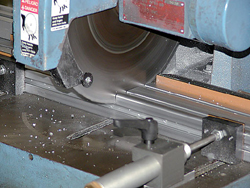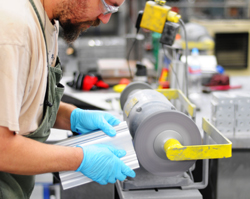Fabrication & Finishing
Cutting/Forming
 |
 |
 |
The first step in almost any aluminum extrusion fabrication process is precision cutting, often followed by deburring and punching or forming. Extruders will typically have a range of saws, to accommodate various cuts — square, miter, or angle — lengths and cutting tolerances.
While it is often possible, with optimal alloy, profile design and blade selection, to cut extrusions without burrs, deburring may be required for specific parts and performance requirements. Mechanical deburring, using a brush or grinder, is frequently used, but tumble deburring, in which quantities of small to mid-size parts are tumbled with an abrasive media to remove any burrs, is also common.
Often, a following step will involve punching and/or forming the extrusion with mechanical presses and part-specific tooling to add holes, slots, or other functional features. For more complex parts, CNC machining may be employed.
Given the wide range of basic cutting, punching, and forming processes available, it is recommended that you discuss component requirements with an extruder. Find an Extruder can help locate an extruder with the right fabrication experience.
Images: Futura Industries, Hydro Aluminum
 -
-




 |
|